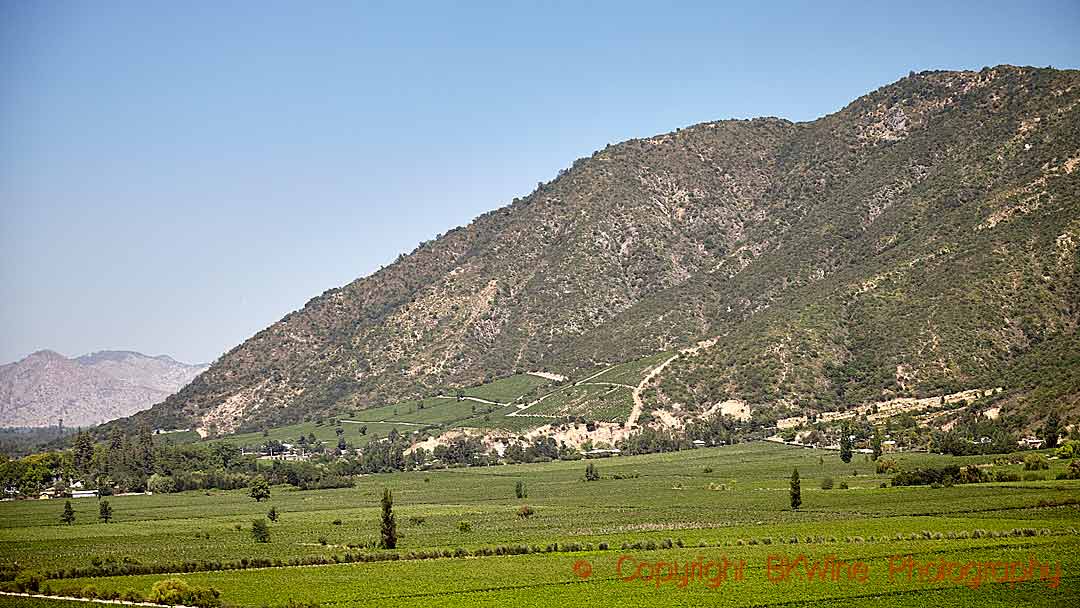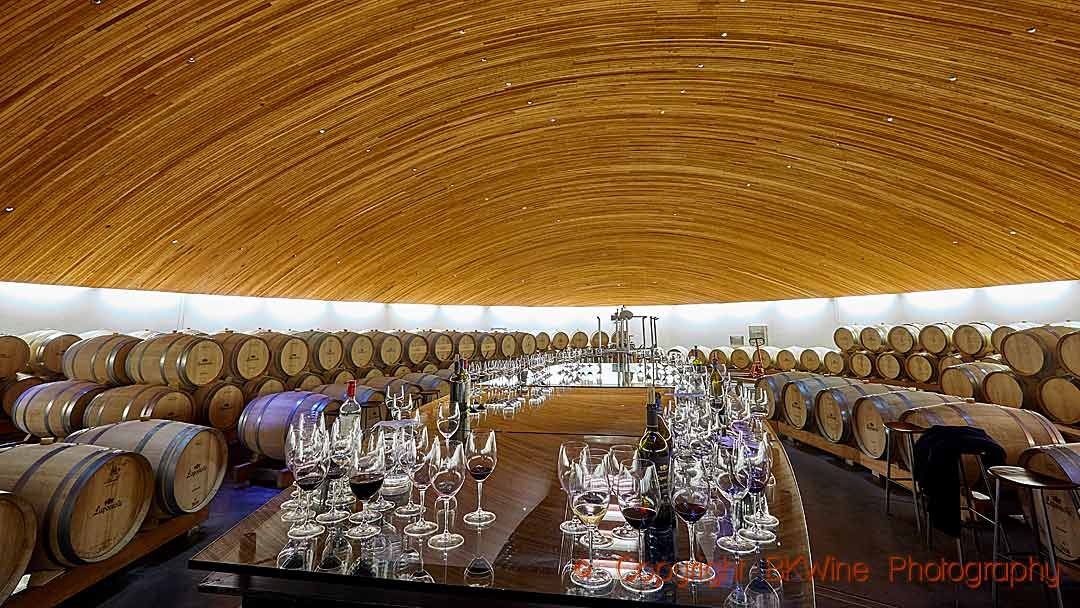Chile has its fair share of French wine producers. And who can blame the French for trying their luck here? Chile is a magnificent country for viticulture. In 1994 Alexandra Marnier Lapostolle fell in love with the Colchagua Valley and, more specifically, a small part of it called Apalta Valley. She launched Lapostolle Wines, and very soon after, she gained fame for her wines Clos Apalta and Cuvée Alexandre.
Lapostolle Wines owns 370 hectares of vineyards in three different wine regions in Chile: in Casablanca, with a cool(ish) climate thanks to its proximity to the Ocean, and in two much warmer regions in Central Valley (Valle Central): Cachapoal and Colchagua. The company produces 2,4 million bottles annually.
Chile has many strong points as a wine country. One is the dry and sunny summer; another is the cold South Pacific Ocean that brings freshness to many of the vineyards. Chile is a very long country, more than 4000 kilometres, but not very wide.
This article has been published in a shorter version on Forbes.com.
Colchagua is a two hours’ drive south of Santiago, Chile’s capital. It is a warm and sunny region, famous for its red wine, but with some cooler spots here and there where the temperature differences between day and night (the “thermal amplitude”) can be substantial. One of these cooler locations is Apalta, a 20-minute drive east from the town of Santa Cruz, the main metropolis (a big word in this case, it’s a charming rural town) of the region.
“Apalta is our true home”, says Andrea Leon, winemaker at Lapostolle Wines. “We are lucky to have some very old vines here.” We met Andrea on Zoom recently to hear more about Apalta and Lapostolle and to taste two new releases together, Clos Apalta 2017 and Cuvée Alexandre Syrah 2018.
Watch the video below, from a visit to the vineyards and winery.
Out of Lapostolle’s 370 hectares, 60 ha are in Apalta, which is, since 2018, a DO, denominación de origen, recognised as being one of the best for red wines in Chile.
Are there regional variations in Colchagua, so that you can distinguish wines from one part from others? We asked Andrea. Yes, there is a specific “Apalta style”, according to Andrea, that shows in all the wines. “They have good acidity and are more driven towards red fruit; also, they have tannins that are quite active.”
In the south Apalta’s border is the Tinguiririca River, and the vineyards are surrounded by mountains on the other three sides. It is a well-defined and stunningly beautiful area of around 1000 hectares in total, made famous by Lapostolle and its neighbours Montes, Las Niñas and Neyen. As we have visited all four on our numerous (and popular) wine tours of Chile, we can definitely say that the wines of Apalta are of high quality.
The many different altitudes, exposures and types of soil – granite, alluvial, less or more organic material and so on – give complexity in the wines”, says Andrea. “Some of the vineyards have southern exposure, which means cooler as we are in the southern hemisphere.”
They start picking the lower part of the hills in April and the top of the hills later, not until the beginning of May in certain vintages. “This means a huge palette of tastes. We have parcels in the lower parts, in the middle and on the top where it is cooler. The grapes from the top parts give us spiciness”.
Cuvée Alexandre Syrah
“We have syrah on 17 different parcels on steep hills sides. These we use for blending into our Cuvée Alexandre Syrah.”
Syrah is one of the best grapes in Apalta, according to Andrea. “Syrah is ideally suited to the climate and amazing on different altitudes.”
She always looks for intensity and freshness. “I never acidify. Syrah has a lovely balance, always with notes of freshness, and peppery. The acidity level doesn’t drop dramatically when the alcohol rises. That is the beauty of syrah. There is really no need to acidify.”
The malolactic fermentation is made naturally and sometimes only finishes at the end of October.
“Cuvée Alexandre Syrah is special”, says Andrea, “we make only 12 000 bottles of each vintage. We select the best syrah plots to make this cuvée.”
They handpick and destem but don’t crush the berries, so a bit of intracellular fermentation takes place inside the berries, emphasising the fruit. Andrea uses native yeast when she can. “We do a couple of punch-downs, but we are careful not to overdo the extraction.”
The yield for the Cuvée Syrah is around 6 tons per hectare (~40 hectolitres per hectare), which is low.
They also make a Cuvée Alexandre Merlot, which is on the picture below.
Lapostolle Cuvée Alexandre Syrah 2018 is an excellent wine, already nicely balanced with lovely aromas of fresh red fruit, hints of spices and refreshing acidity. 2018 was a balanced vintage, Andrea tells us, with sufficient winter rains, moderate temperatures during the growing season and harvest at the end of April (~20 euro).
We also taste two older vintages, 2014 and 2010, to see how the wine evolves.
Lapostolle Cuvée Alexandre Syrah 2014 feels perfectly ready to drink. It is smooth and developed with ripe fruit aromas.
Lapostolle Cuvée Alexandre Syrah 2010 feels younger and surprisingly fresh, and very peppery. 2010 was the year of the big earthquake in February. “We were lucky, says Andrea, “the winery survived. Only a few tanks fell, and we lost most of our chardonnay, but the barrels resisted well”. But it took them four months to put the barrels back orderly in the cellar. They had to take out the roof and do it with a big crane.
I visited Chile in May the same year, and I remember seeing stainless-steel tanks that had imploded scattered around the countryside, looking like crushed Coca-Cola cans.
Despite challenging conditions, Andrea and the Lapostolle team managed to do the harvest, and, Andrea says, “the wines we made that year; they are something special.” They harvested in April, a bit earlier than usual, because the irrigation system was damaged. Nevertheless, the result is excellent.
Clos Apalta
Clos Apalta is the top wine, one of the first icon wines in Chile. The first vintage was in 1997. Clos Apalta 2017 that we are tasting with Andrea is the 20th-anniversary vintage as no Clos Apalta was made in 1998.
Carmenère, the emblematic grape of Chile, is always the most important variety in Clos Apalta, with around 50% of the blend. “We have 30 hectares of very old carmenere, planted in 1910”, says Andrea. “Carmenère needs sunlight, and if it is planted in the right spot, it can keep the acidity.”
Carmenère is blended with cabernet sauvignon, merlot and sometimes a little bit of petit verdot.
Clos Apalta 2017 is delicious with refined, intense and concentrated fruit aromas and complexity. The structure is firm, with smooth tannins. The palate shows oak aromas, blackberries and lovely freshness, the hallmark of carmenère. “This is more in the style of a classic Bordeaux”, says Andrea. Which is maybe not so surprising, considering that the owners are French and their consultant is the famous Michel Rolland from Bordeaux. (~130 euro)
The vines are planted with a high density for Chile, 6,600 vines per hectares. “We get small concentrated berries”, says Andrea. In 2017 they started harvesting merlot already in February. “It was a hot vintage”, Andrea says, “so canopy management was important; the leaves will give shade. We had a lot of rain in the winter and good conditions in the summer, a lot of sunlight. The roots are deep, and some parts are dry farmed.”
In the amazingly spectacular winery, Clos Apalta ferments in small oak vats with extended skin contact for up to 45 days. Andrea is decreasing the percentage of new oak barrels for the ageing, which seems like a good idea. It will still be 14 to 16 months ageing in barrels, but 15 to 25% used barrels instead of 100% new ones.
The old vines on the estate are not grafted, and actually, you don’t need to graft on American rootstocks because Chile is a phylloxera free country. Some winemakers do it anyway, also Andrea, sometimes.
“There are many reasons for using rootstocks beyond phylloxera”, she says. “Drought resistance, type of root growth (more lateral or vertical growth), lime or salinity in the soil, nutrient intake, among many others. So, we can use the rootstock as a tool in certain parts of the vineyards for new plantings. On others, we can go own root.”
Harvest of the new vintage 2021 is underway. How is it looking? “It’s looking good”, declares Andrea. “We have a balanced amount of fruit, it has not been that hot in the summer, and we had good rains in the winter.”
We have more great wines to look forward to from Lapostolle Wines.
Travel
There are many, many outstanding wines made in Chile and beautiful wineries to visit. You can taste the wines, visit the wineries and have a good time on a wine tour to Chile and Argentina with BKWine.
Travel to the world’s wine regions with the wine experts and the wine travel specialist.
Good-time wine tours. BKWine wine tours.




















